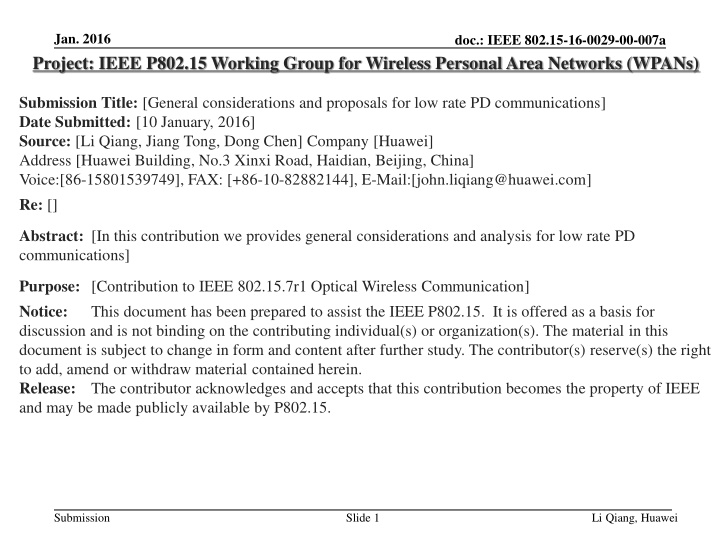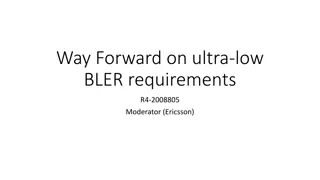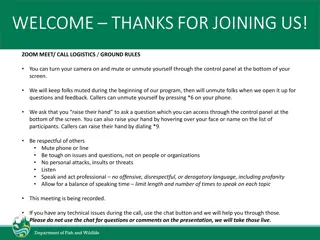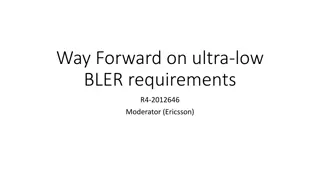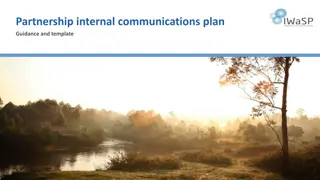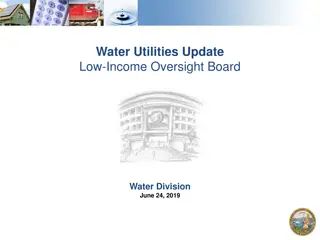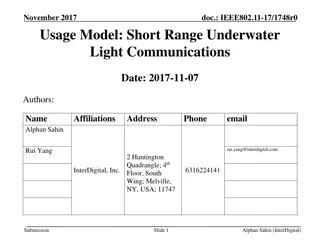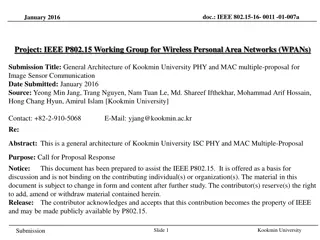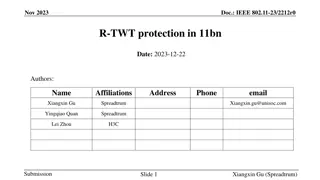General considerations and proposals for low-rate PD communications
This submission provides insights and proposals on low rate personal data communications within the IEEE P802.15 Working Group for Wireless Personal Area Networks. It discusses various considerations for enhancing communication efficiency in low rate scenarios.
Download Presentation

Please find below an Image/Link to download the presentation.
The content on the website is provided AS IS for your information and personal use only. It may not be sold, licensed, or shared on other websites without obtaining consent from the author.If you encounter any issues during the download, it is possible that the publisher has removed the file from their server.
You are allowed to download the files provided on this website for personal or commercial use, subject to the condition that they are used lawfully. All files are the property of their respective owners.
The content on the website is provided AS IS for your information and personal use only. It may not be sold, licensed, or shared on other websites without obtaining consent from the author.
E N D
Presentation Transcript
Jan. 2016 Project: IEEE P802.15 Working Group for Wireless Personal Area Networks (WPANs) doc.: IEEE 802.15-16-0029-00-007a Submission Title: [General considerations and proposals for low rate PD communications] Date Submitted: [10 January, 2016] Source: [Li Qiang, Jiang Tong, Dong Chen] Company [Huawei] Address [Huawei Building, No.3 Xinxi Road, Haidian, Beijing, China] Voice:[86-15801539749], FAX: [+86-10-82882144], E-Mail:[john.liqiang@huawei.com] Re: [] Abstract: [In this contribution we provides general considerations and analysis for low rate PD communications] Purpose: [Contribution to IEEE 802.15.7r1 Optical Wireless Communication] Notice: This document has been prepared to assist the IEEE P802.15. It is offered as a basis for discussion and is not binding on the contributing individual(s) or organization(s). The material in this document is subject to change in form and content after further study. The contributor(s) reserve(s) the right to add, amend or withdraw material contained herein. Release: The contributor acknowledges and accepts that this contribution becomes the property of IEEE and may be made publicly available by P802.15. Submission Slide 1 Li Qiang, Huawei
Jan. 2016 doc.: IEEE 802.15-16-0029-00-007a General considerations and proposals for low rate PD communications Li Qiang, Jiang Tong, Dong Chen Huawei Submission Slide 2 Li Qiang, Jiang Tong, Dong Chen Huawei
Jan. 2016 doc.: IEEE 802.15-16-0029-00-007a System architecture The following transfer modes are defined for low rate PD communications D2D/IoT data transmission and Relay mode with ID information with PHY/ MAC frame for applications C2, C3, C4, C5 and C6. Uni-directional data transfer mode for applications C1 C6. Bi-directional data transfer mode for applications C1-C6 Device Device D2D architecture Star architecture Cable/ Power Line Cable/ Power Line CCo CCo DL DL/UL Local server Local server Device Device Device Device Device Device Access Network GW GW VPAN1 VPAN2 VPAN3 : Modem GW: Home Gateway Star, Uni-directional Li Qiang, Jiang Tong, Dong Chen Huawei Star, Bi-directional Submission Slide 3
Jan. 2016 doc.: IEEE 802.15-16-0029-00-007a Low rate PD applications D2D/IoT data transmission mode File sharing Vehicle to vehicle Uni-directional transmission mode Information forwarding Indoor navigation Tell me about all the restaurants in this mall Bi-directional transmission mode Interactive navigation Smart home Submission Slide 4 Li Qiang, Jiang Tong, Dong Chen, Huawei
Jan. 2016 doc.: IEEE 802.15-16-0029-00-007a D2D data transmission mode Functions Beacon or Non-beacon Association Data transfer Considerations Non-beacon enabled is preferred. Needed Contention based VPAN maintenance Link status monitoring Fast link recovery Supported Handover is not supported Needed. Specific scheme is dependent on the modulation scheme. Interference management Mobility management Dimming and flickering control Submission Slide 5 Li Qiang, Jiang Tong, Dong Chen, Huawei
Jan. 2016 doc.: IEEE 802.15-16-0029-00-007a Unidirectional data transmission mode Functions Beacon or Non-beacon Considerations It is preferred beacon is used for the instructions of broadcasted data streams No association TDM of different data streams is preferred Association Data transfer VPAN maintenance Link status monitoring: no need Fast link recovery: no need Supported Handover is not supported Needed. Specific scheme is dependent on the modulation scheme. Interference management Mobility management Dimming and flickering control Submission Slide 6 Li Qiang, Jiang Tong, Dong Chen, Huawei
Jan. 2016 doc.: IEEE 802.15-16-0029-00-007a Bidirectional data transmission mode Functions Beacon or Non-beacon Association Data transfer Considerations Beacon enabled is preferred. Needed Contention based / Contention free VPAN maintenance Link status monitoring Fast link recovery Supported Handover is supported Needed. Specific scheme is dependent on the modulation scheme. Interference management Mobility management Dimming and flickering control Submission Slide 7 Li Qiang, Jiang Tong, Dong Chen, Huawei
Jan. 2016 doc.: IEEE 802.15-16-0029-00-007a Joining a VPAN Current 15.7 association procedures may be reused with potential optimizations Current 15.7 association procedures The association response command is send to the device using indirect transmission in 15.7 (2011). To reduce the latency, direct transmission may be used. Submission Slide 8 Li Qiang, Jiang Tong, Dong Chen Huawei
Jan. 2016 doc.: IEEE 802.15-16-0029-00-007a Data transfer in beacon enabled VPANs Command frames (association request command, GTS request command, etc) It is preferred that command frames are sent via contention based channel access Data frame Burst mode / Packed mode /Single mode transmissions are adopted in 15.7 It is preferred that Burst mode / Packed mode /Single mode are adopted for data transfer in 15.7r1 Submission Slide 9 Li Qiang, Jiang Tong, Dong Chen Huawei
Jan. 2016 doc.: IEEE 802.15-16-0029-00-007a Data transfer in beacon enabled VPANs Unicast (e.g. Video/audio service with QoS support ) Flow establishment before data transmission is preferred Link adaptation: modulation and coding scheme (MCS) is selected based on metric reports for each transmission Flow establishment: originator provide traffic specification parameters(for example, traffic priority, maximum latency, etc.) to the recipient. Recipient can assess whether to accept the request or not. Submission Slide 10 Li Qiang, Jiang Tong, Dong Chen Huawei
Jan. 2016 doc.: IEEE 802.15-16-0029-00-007a Data transfer in beacon enabled VPANs Broadcast Link adaptation: MCS selection is up to the CCo. It should be able to serve most devices in the VPAN with high reliability Submission Slide 11 Li Qiang, Jiang Tong, Dong Chen, Huawei
Jan. 2016 doc.: IEEE 802.15-16-0029-00-007a Data transfer in beacon enabled VPANs Acknowledgement and retransmission Stop-and-Wait ARQ Selective Repeat ARQ Selective repeat ARQ is preferred for 15.7r1 due to higher efficiency (a) Stop-and-wait ARQ Originator Frame1 NACK Frame2 ACK Frame1 (ReTx) Recipient (b) Selective repeat ARQ Originator Acknowledgement (Frame 2 is not recived) Frame2 (ReTx) Frame1, 2, .., N Recipient Submission Slide 12 Li Qiang, Jiang Tong, Dong Chen Huawei
Jan. 2016 doc.: IEEE 802.15-16-0029-00-007a Contention based channel access Hidden node problem on uplink Potential solution: RTS/CTS mechanism CCo FOV RTS/CTS mechanism RTS/CTS mechanism Each device shall send a RTS frame before it communicate to the CCo. The device cannot try to contend the channel unless it receives the CTS frame from the CCo. In the RTS frame, the device shall indicate the total duration of its transmission, i.e., TRTS. In the CTS frame, the CCo shall also indicate TCTS, and the information of the device that is allowed to transmit in this contention period. Device1 Device2 Hidden node problem Hidden node problem Because of the limitation of FOV, Device 1 cannot hear the signal from Device2. Therefore Device1 may not be able to sense the signal transmitted by Device2 when Device2 is making a random access. It results in collision. Current CSMA/CA procedure in 802.15.7 does not provide any hidden node avoidance mechanisms. Submission Slide 13 Li Qiang, Jiang Tong, Dong Chen Huawei
Jan. 2016 doc.: IEEE 802.15-16-0029-00-007a Contention free channel access In 802.15.7, CFP is used for contention free channel access. CFP is divided into several GTS and each GTS is assigned to one device. As specified by 802.15.7, the coordinator shall be able to store all the information necessary to manage seven GTSs. A single GTS may extend over one or more superframe slots. For 15.7r1, it is preferred that dedicated resource allocation can be more flexible. So that users with different QoS requirements can be simultaneously served. Beacon Beacon CAP GTS1 GTS2 GTS3 GTS4 GTS5 GTS6 GTS7 CAP GTS allocations in 802.15.7 Submission Slide 14 Li Qiang, Jiang Tong, Dong Chen, Huawei
Jan. 2016 doc.: IEEE 802.15-16-0029-00-007a VPAN maintenance Link status monitoring The device send metric reports to the associated CCo periodically. Event-triggered metric reports is also supported. Fast link recovery The fast link recovery procedure defined by 15.7 can be reused with potential optimizations Link failure If can not be recovered by fast link recovery, the device may assume link failure and may disassociate. Fast link recovery specified by 802.15.7 Submission Slide 15 Li Qiang, Jiang Tong, Dong Chen Huawei
Jan. 2016 doc.: IEEE 802.15-16-0029-00-007a Mobility management Horizontal handover between neighbor VPANs is crucial to ensure continuous user experience. Possible handover schemes Device initiated handover CCo assisted handover HO related information HO command Device Device Associated VPAN Target VPAN Associated VPAN Target VPAN Device initiated handover Device initiated handover: the device may associate with a neighbouring VPAN before it leaves its VPAN and request for the time/frequency/time-frequency resources for its data transmission. CCo CCo assisted handover assisted handover: associated CCo predicts the potential handover of a device. Associated CCo may send HO related information to the target CCo. The target CCo may reserve resources for the device in advance. Submission Slide 16 Li Qiang, Jiang Tong, Dong Chen, Huawei
Jan. 2016 doc.: IEEE 802.15-16-0029-00-007a Interference management Type of interference Ambient light and artificial lighting Inter-VPAN interference Interference avoidance approaches for inter-VPAN interference WDM (neighboring VPANs use different wave length bands) FDM (neighboring VPANs use different modulation frequencies) CDM (neighboring VPANs use different cover codes, needs tight time sync) CDM (neighboring VPANs use different time slots, needs tight time sync) Interference detection and report A CCo can detect the interference by itself. A device may measure the interference experienced and report to associated CCo Submission Slide 17 Li Qiang, Jiang Tong, Dong Chen, Huawei
Jan. 2016 doc.: IEEE 802.15-16-0029-00-007a Interference management Interference coordination Centralized interference coordination Distributed interference coordination Global controller Negotiation CCo Negotiation via device Device Device Device Device VPAN1 VPAN2 VPAN1 VPAN2 VPAN3 Centralized interference mitigation Centralized interference mitigation A global controller is needed. It shall be able to collect the interference information from different CCos which it manages. The global controller is responsible for the coordination among different VPANs. Distributed interference mitigation Distributed interference mitigation This approach applies to the case that the device can detect the interference from other CCos. The CCos of the two interfering VPANs shall negotiate with each other for interference avoidance. The interfered device may be able to communicate with the two CCos and act as a relay device for the negotiation between the two CCos. Submission Slide 18 Li Qiang, Jiang Tong, Dong Chen, Huawei
Jan. 2016 doc.: IEEE 802.15-16-0029-00-007a Conclusions In this contribution, we provide general considerations for low rate PD communications. We provide analysis and our preferences on the following aspects System architecture Association Data transfer Channel access VPAN maintenance Mobility management Interference management - - - - - - - Submission Slide 19 Li Qiang, Jiang Tong, Dong Chen, Huawei
